
Underplanting can be good for the cherry tree if you choose suitable plants. This article shows what needs to be considered so that the subplants do not become competition for the tree.
In a nutshell
- Tree discs can be planted or left empty
- suitable plants cope with the living conditions under a cherry tree
- Herbs can help the tree against pests or diseases
Table of contents
- Plant tree disc
- Notes on plant selection
- Underplants for the cherry tree
- frequently asked Questions
Plant tree disc
Plant the tree disc of a tree, so that weeds cannot take nutrients or moisture away from the tree. However, it is not absolutely necessary to plant the tree disc. You can also simply mulch the crown area or, as can often be seen in meadows, grass and wild herbs grow around the trees. The advantage of conscious planting is that you can choose extra plants that benefit the tree.
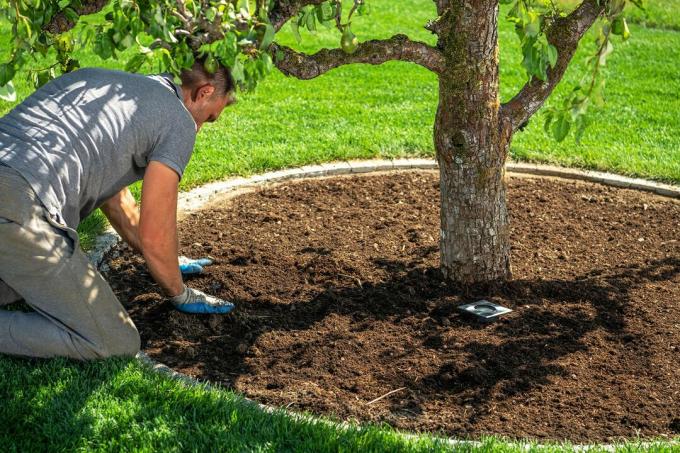
Notes on plant selection
The right choice of plants is crucial for the planting to succeed and remain beautiful for several years. Above all, they have to cope with the cherry tree, which takes away light, nutrients and water. Plants that only have a medium nutrient and water requirement and that do not root too deeply are particularly suitable. Also, they should with the
penumbra get under the tree.Underplants for the cherry tree
Nasturtium (Tropaeolum majus)
The nasturtium makes a very good choice as a subplant for cherry trees, as it can shade the entire area and at the same time sets very beautiful accents with its yellow to orange flowers. However, cress is not hardy and you need it reseed every year, but this can also be useful as it makes work around the tree easier if the tree disc is temporarily free.
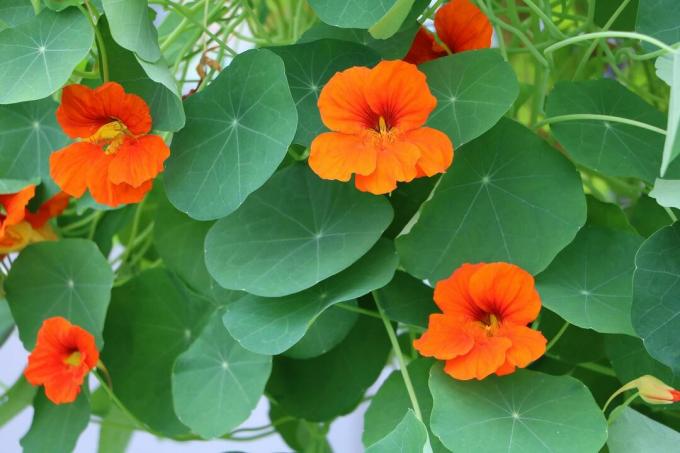
- Characteristics: trailing or climbing, many flowers and leaves throughout the year
- Location: sunny to semi-shady, moist, nutritious
- planting time: prefer in the warm in April, from Plant out in May
- Care: keep moist, initially remove weeds
- To use: keeps aphids away from the tree, flowers are edible
Garlic (Allium sativum)
Garlic and other bulbous vegetables are suitable as underplanting for cherry trees if they are not to be permanent. The bulbs or tubers stuck in spring and in autumn you can harvest the garlic again.

- Characteristics: Annual bulb vegetable cultivated, leaves up to 30 cm long, overwintering plants die in the 2nd week of life. year in bloom
- Location: sunny to semi-shady, well-drained soil, medium nutrient requirement
- planting time: stuck in spring
- Care: mulch, keep moist, remove weeds
- To use: edible, keeps dry for a long time, keeps aphids away from the tree
lily of the valley (Convallaria majalis)
Lily of the valley is one of the early bloomers. They are particularly beautiful on a tree grate if you keep them with other bulbs that bloom earlier. These include, for example, snowdrops, crocuses, tulips and daffodils.
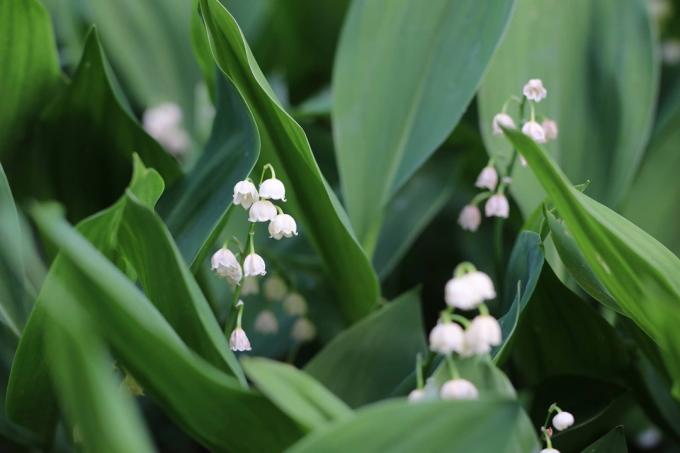
- Characteristics: Rhizome plant, no higher than 20 cm, white flowers, forms red berries
- Location: partial shade to shade, moist, well-drained soil
- planting time: plant and propagate in the fall or spring, dividing and replanting rhizomes
- Care: mulch, keep moist, fertilize in spring, divide plants from time to time
- To use: ground-covering vegetation, to protect cherries from the Monilla peak drought
A notice: Lily of the valley is poisonous because of the risk of confusion should youdo not plant them together with wild garlic.
peppermint (Mentha x piperita)
Peppermint is well known because you can use the plant in many ways. It is also suitable as a subplant for cherry trees.

- Characteristics: creeping spread, forms numerous stolons, characteristic smell, purple flowers
- Location: sunny to semi-shady, not too dry, well-drained soil
- planting time: plant in autumn or spring, plants are easy to propagate
- Care: do not let dry out, pruning ensures more compact growth
- To use: the essential oils of the mint make the cherry tree more resistant to external influences, the mint itself is edible and is particularly suitable for teas
A notice: Peppermint grows very vigorously. Without a root barrier, it can quickly leave the tree pit and grow in adjacent beds or meadows.
Red Foxglove (digitalis purpurea)
The red foxglove is one native poisonous plant, which is often found in forests. Those who have children and pets should exercise caution when using this plant in the garden.
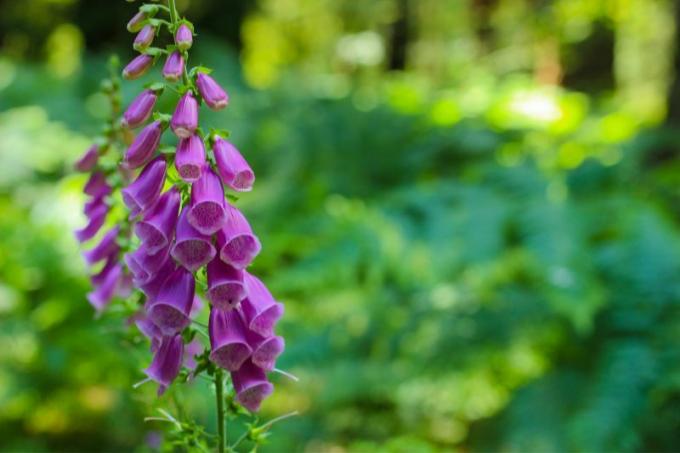
- Characteristics: perennial up to one meter high, often only biennial, bell-shaped purple flowers
- Location: semi-shady, well-drained, not too dry soil
- planting time: possible all year round, best in autumn or spring, likes to self-seed
- Care: mulch between the plants, keep moist, self-sowing is not desirable, remove faded leaves
- To use: is intended to prevent gum flow on the cherry tree
chives (Allium schoenoprasum)
Chives are a clump-forming onion plant. With its purple flowers, it attracts countless insects.
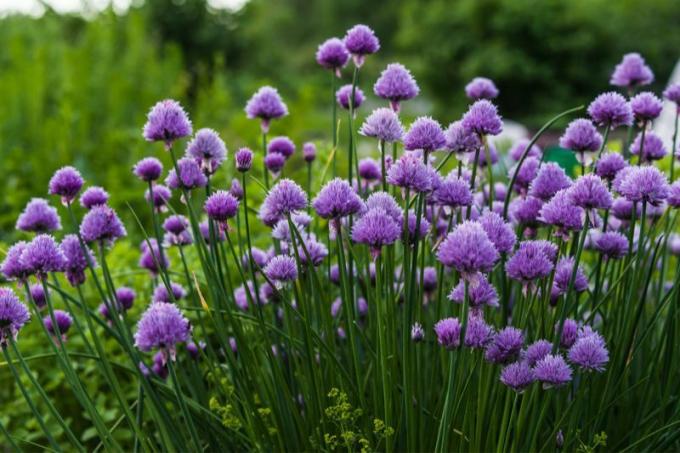
- Characteristics: forms long chimneys, multiplies by breeding onions, perennial
- Location: sunny to semi-shady, well-drained, nutrient-rich soil
- planting time: from spring to autumn, easy to divide and replant
- Care: mulch, do not let dry out, cut back regularly for more compact growth
- To use: keeps aphids away from the tree, leaves and Flowers are edible
lemon balm (Melissa officinalis)
The lemon balm gives various dishes and teas a lemony aroma and also smells very pleasant. When the lemon balm blooms, it is very popular with insects.

- Characteristics: Perennial, up to one meter tall, bushy growth, small, white flowers
- Location: sunny to semi-shady, well-drained soil
- planting time: in the spring
- Care: do not let dry out, promote bushy growth by pruning, mulch
- To use: strengthens the immune system of the cherry tree, edible
frequently asked Questions
In the first few years, special care must be taken to ensure that the plants do not dry out. Therefore, the soil is mulched and watered regularly. Weeds should be removed, and spring is the right time to fertilize the tree disc and the tree.
There are various ways of successfully harvesting despite planting. In the case of older trees, where a ladder is used, appropriate places can be planned for this before planting. With young trees, it is sufficient to leave gaps in the planting.
A planting can be realized at the same time as the tree is planted. In most cases, however, a few years are waited until the tree has successfully grown in. Until then, the tree disc is mulched and kept free of vegetation.



